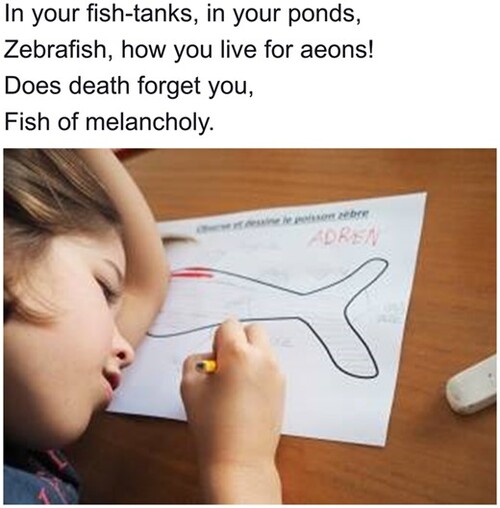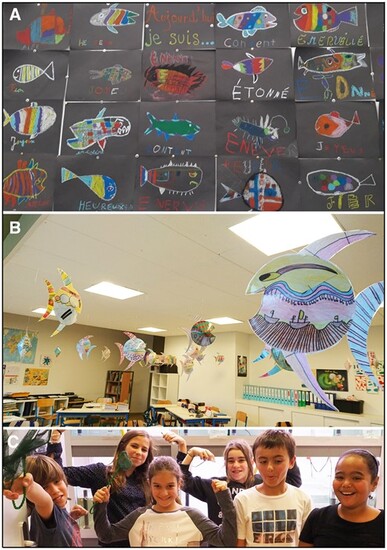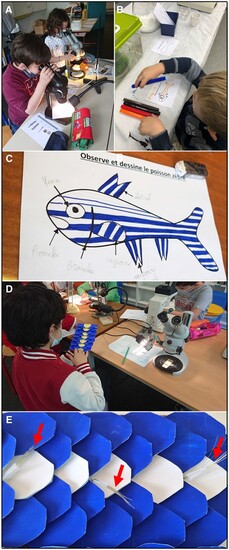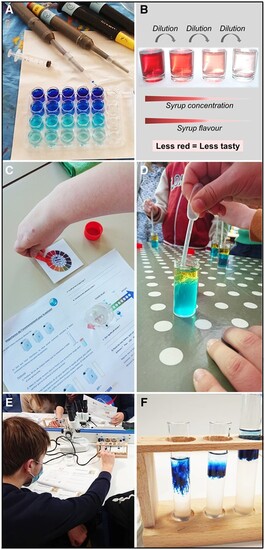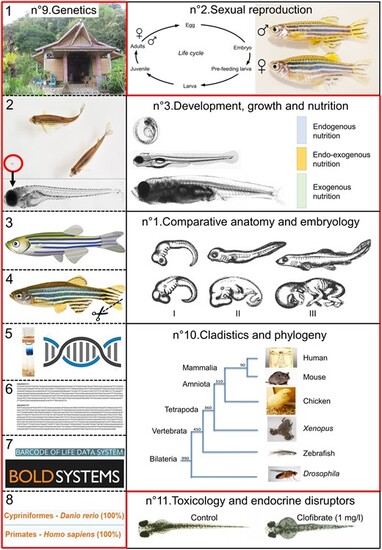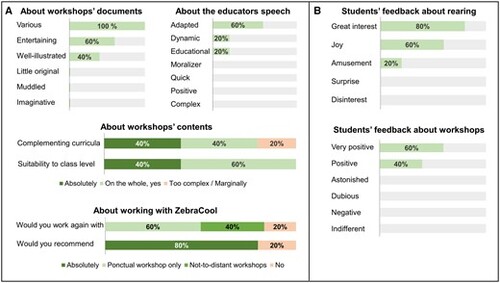- Title
-
A cognitive and sensory approach based on workshops using the zebrafish model promotes the discovery of life sciences in the classroom
- Authors
- Bourcier, L.M., Babin, P.J.
- Source
- Full text @ Biol Methods Protoc
|
Sweet dreams and beautiful reality (adapted and translated from a poem by Guillaume Apollinaire, The Bestiary: or Orpheus’s Procession, 1911). The serenity of a child drawing a zebrafish. |
|
ZebraCool is fun and lets us express our inner fish. (A) Decorative fish fresco around the theme ‘Today I am…’. Students drew a fish and labelled their drawing to indicate how they felt that day: e.g., proud (fier), happy (heureux), pleased (content), amazed (émerveillé), angry (en colère), surprised (étonné). (B) An elementary school classroom decorated by the children to illustrate the fish theme. (C) A group of students motivated to learn more about zebrafish. |
|
The pleasure of discovering the anatomy and development of zebrafish during elementary school workshops. (A) Recognize and classify different developmental stages of zebrafish using observation under the stereomicroscope. (B) Draw an adult zebrafish from an animal observed in its aquarium and learn to distinguish males from females. (C) Annotated drawing of an adult zebrafish. (D) Observing the scales of zebrafish. The comparison of what is observed under the stereomicroscope with a model made of paper that the child holds in his or her hands. (E) Cardboard model of part of the skin of the adult zebrafish with its covering scales and the sensory hair cells of the lateral line neuromasts (red arrow). |
|
It is nice to experiment, but what do the colours means? (A) The principle of dilution with coloured chemistry workshop. Methylene blue serial dilutions in multi-well plates. (B) Dilutions of strawberry syrup in water to correlate the decrease in colour observed with the decrease in taste according to the dilution made. (C) The pH of water workshop. Using pH paper to measure water pH used for fish rearing. (D) Impact of pollution on the food chain workshop. Experiment that mimics the impact of an oil spill on aquatic organisms through the modification of air/water gas exchanges due to the hydrophobic nature of oil. (E, F) DNA extraction performed during the genetics workshop. |
|
Modular architecture of the ZebraCool programme. Table illustrates the design of the combined GDE workshop. Left panel: Dotted black lines define the steps of the Genetic workshop (n°9). Right panel: Full black lines partially surround two of the twelve thematic workshops using the zebrafish model; red lines surround the four thematic workshops that constitute the combined GDE workshop (n°1, 3, 9, and 10). See also Supplementary file documents: Educational presentation used by the ZebraCool educators and Students’ notebook for the GDE combined workshop. Additional workshops can be associated, such as sexual reproduction and/or toxicology and endocrine disruptors to propose a broader multi-thematic activity, if desired. |
|
What feelings do ZebraCool workshops elicit? A satisfaction questionnaire was submitted to participants after the workshops (see Supplementary document: ZebraCool survey questionnaire). Example of a post-annual project assessment (see Supplementary document: André Peynaud Elementary School for additional data): (A) Teachers’ opinions about the fun and educational quality of the workshops, and whether or not implementing the ZebraCool programme was straightforward. (B) The emotional impact on pupils of zebrafish rearing and the workshops. Eight classes involved, from CP (Year 2/1st grade) to CM2 (Year 6/5th grade), with roughly 25 pupils per class and several presentations per class during the school year. The overall satisfaction rating from teachers following the implementation of this annual project was 4.5/5. |

